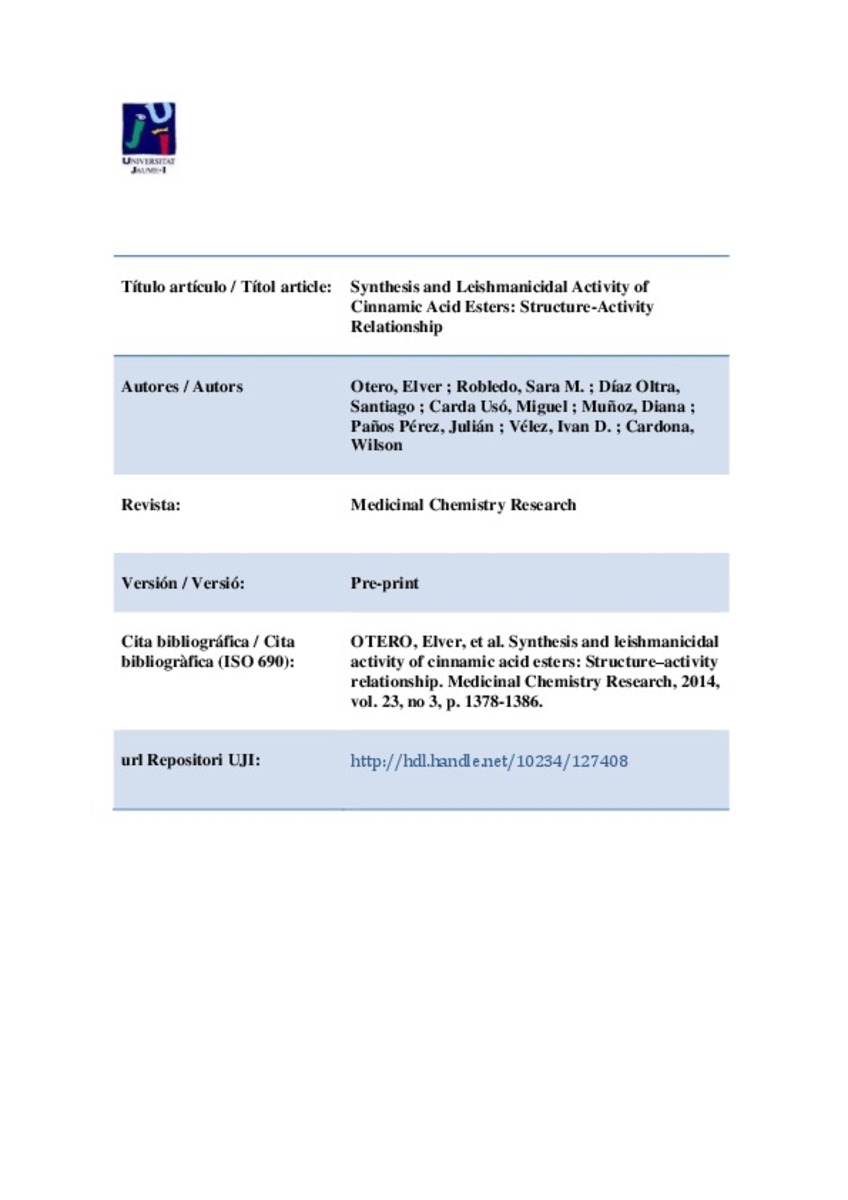Mostrar el registro sencillo del ítem
Synthesis and leishmanicidal activity of cinnamic acid esters: structure–activity relationship
| dc.contributor.author | Otero, Elver | |
| dc.contributor.author | Robledo, Sara M. | |
| dc.contributor.author | Diaz-Oltra, Santiago | |
| dc.contributor.author | Carda, Miguel | |
| dc.contributor.author | Muñoz, Diana | |
| dc.contributor.author | Paños Pérez, Julián | |
| dc.contributor.author | Vélez, Iván D. | |
| dc.contributor.author | Cardona Galeano, Wilson Isidro | |
| dc.date.accessioned | 2015-07-13T10:50:33Z | |
| dc.date.available | 2015-07-13T10:50:33Z | |
| dc.date.issued | 2014 | |
| dc.identifier.citation | OTERO, Elver, et al. Synthesis and leishmanicidal activity of cinnamic acid esters: Structure–activity relationship. Medicinal Chemistry Research, 2014, vol. 23, no 3, p. 1378-1386. | ca_CA |
| dc.identifier.issn | 1054-2523 | |
| dc.identifier.issn | 1554-8120 | |
| dc.identifier.uri | http://hdl.handle.net/10234/127408 | |
| dc.description.abstract | Several cinnamic acid esters were obtained via Fischer esterification of cinnamic acids derivatives with aliphatic alcohols. Structures of the products were elucidated by spectroscopic analysis. The synthesized compounds were evaluated for antileishmanial activity against L. (V) panamensis amastigotes and cytotoxic activity was evaluated against mammalian U-937 cells. The compounds 11, 15–17, and 23, were active against Leishmania parasite and although toxic for mammalian cells, they still are potential candidates for antileishmanial drug development. A SAR analysis indicates that first, while smaller alkyl chains lead to higher selectivity indices (10, 11 vs. 12–17); second, the degree of oxygenation is essential for activity, primarily in positions 3 and 4 (17 vs. 18–20 and 22); and third, hydroxyl groups increase both activity and cytotoxicity (14 vs. 23). On the other hand, the presence of a double bond in the side chain is crucial for cytotoxicity and leishmanicidal activity (12 vs. 21). However, further studies are required to optimize the structure of the promising molecules and to validate the in vitro activity against Leishmania demonstrated here with in vivo studies. | ca_CA |
| dc.description.sponsorShip | The authors thank Dr. Javier Garcés for his help in this study. We acknowledge the support by the Universidad de Antioquia (Estrategia de Sostenibilidad 2013–2014 and CIDEPRO) and Colciencias (contract No. 357-2011). | ca_CA |
| dc.format.extent | 9 p. | ca_CA |
| dc.format.mimetype | application/pdf | ca_CA |
| dc.language.iso | eng | ca_CA |
| dc.publisher | Springer | ca_CA |
| dc.relation.isFormatOf | Synthesis and leishmanicidal activity of cinnamic acid esters: Structure–activity relationship. Medicinal Chemistry Research, 2014, vol. 23, no 3, p. 1378-1386. | ca_CA |
| dc.relation.isPartOf | Medicinal Chemistry Research, 2014, vol. 23, no 3 | ca_CA |
| dc.rights | © Springer International Publishing AG, Part of Springer Science+Business Media | ca_CA |
| dc.rights.uri | http://rightsstatements.org/vocab/InC/1.0/ | * |
| dc.subject | leishmaniasis | ca_CA |
| dc.subject | antiprotozoal | ca_CA |
| dc.subject | caffeic acid | ca_CA |
| dc.subject | cinnamic acid ester | ca_CA |
| dc.title | Synthesis and leishmanicidal activity of cinnamic acid esters: structure–activity relationship | ca_CA |
| dc.type | info:eu-repo/semantics/article | ca_CA |
| dc.identifier.doi | http://dx.doi.org/10.1007/s00044-013-0741-y | |
| dc.rights.accessRights | info:eu-repo/semantics/openAccess | ca_CA |
| dc.relation.publisherVersion | http://link.springer.com/article/10.1007%2Fs00044-013-0741-y | ca_CA |
Ficheros en el ítem
Este ítem aparece en la(s) siguiente(s) colección(ones)
-
QUIO_Articles [690]
Articles de publicacions periòdiques







